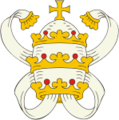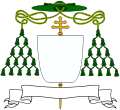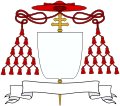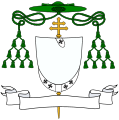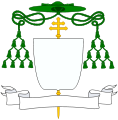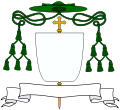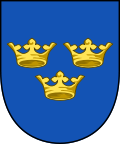- Crown (heraldry)
-
A Crown is often an emblem of the monarchy, a monarch's government, or items endorsed by it; see The Crown. A specific type of crown (or coronet for lower ranks of peerage) is employed in heraldry under strict rules. Indeed some monarchies never had a physical crown, just a heraldic representation, as in the constitutional kingdom of Belgium.
Crowns are also often used as symbols of religious status or veneration, by divinities (or their representation such as a statue) or by their representatives, e.g. the Black Crown of the Karmapa Lama, sometimes used a model for wider use by devotees.
A crown can be a charge in a coat of arms, or set upon the shield to signify the status of its owner.
Contents
As a display of rank
If the bearer of a coat of arms has the title of baron or higher (or hereditary knight in some countries), he or she may display a coronet of rank above the shield, usually below the helm in British heraldry, often above the crest (if any) in Continental heraldry.
In this case the appearance of the crown follows a strict set of rules. A royal coat of arms may display a royal crown such as that of Norway. Princely coats of arms display a princely crown and so on right down to the mural crown which is commonly displayed on coats of arms of towns and some republics. These forms of crowns are often inspired by the actual appearance of the respective country's royal and princely crowns.
Ships and other units of some navies have a naval crown above the shield of their coats of arms.
Commonwealth usage
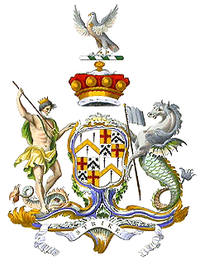 The coat of arms of the Barons Hawke displays a baronial coronet.
The coat of arms of the Barons Hawke displays a baronial coronet.
In formal English the word crown is reserved for the crown of a monarch whereas the word coronet is used for all other noble crowns.
In the peerage of the United Kingdom, the design of a coronet shows the rank of its owner, as in German, French and various other heraldic traditions. The coronet of a duke has eight strawberry leaves, that of a marquess has four strawberry leaves and four silver balls (known as "pearls", but not actually pearls), that of an earl has eight strawberry leaves and eight "pearls" raised on stalks, that of a viscount has sixteen "pearls", and that of a baron has six "pearls". Since a person entitled to wear a coronet customarily displays it in their coat of arms above the shield and below the helm and crest, this can provide a useful clue as to the owner of a given coat of arms.
Members of the British Royal Family have coronets on their coats of arms, and may wear them at coronations. They are according to regulations made by King Charles II in 1661 shortly after his return from exile in France (getting a taste for its lavish court style; Louis XIV started monumental work at Versailles that year) and Restoration, and vary depending upon the prince's relationship to the Monarch. Occasionally additional royal warrants vary the designs for individuals.
In Canadian heraldry, coronets are used to designate descent from United Empire Loyalists. A military coronet signifies ancestors who served in Loyalist regiments during the American Revolution, while a civil coronet is used by all others. The loyalist coronets are used only in heraldry, never worn.

Sovereign - St. Edward's Crown 
Sovereign - Crown of Scotland 
Sovereign - Imperial/Tudor Crown 
Heir Apparent 
Prince or Princess - son or daughter of a sovereign 
Prince or Princess - children of the Heir Apparent 
Prince or Princess - children of other sons of the Sovereign, other princes or princesses 
Prince or Princess - Children of a Daughter of the sovereign. 
Old ducal hat 
Duke 
Marquess 
Earl 
Viscount 
Baron 
Loyalists military coronet (Canadian) 
Loyalists civil coronet (Canadian) Continental usages
Precisely because there are many traditions and more variation within some of these, there is a plethora of continental coronet types. Indeed there are also some coronets for positions that don't exist, or do not entitle use of a coronet, in the Commonwealth tradition.
Such a case in French ('old', i.e. royal era) heraldry, where coronets of rank did not come into use before the 16th century, is the vidame, whose coronet (illustrated) is a metal circle mounted with three visible crosses (no physical headgear of this type known).
Often coronets are substituted by helmets, or only worn on a helmet.
German-Speaking countries
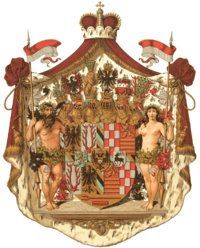 Coat of arms of the principality of Schwarzburg-Sondershausen displaying a Fürstenhut (Princely hat).
Coat of arms of the principality of Schwarzburg-Sondershausen displaying a Fürstenhut (Princely hat).
The Holy Roman Empire and consequently its successor states - Austria, Germany and others - had a very similar system to the British, though the design varied.
- The normal Adelskrone for lower nobility(= Laubkrone) is a golden ring with pearls and precious stones that features eight tines of which typically only five are visible. Out of those the center and the outer tines are normally leaves, whereas the others are headed by pearls. In the southern states of Bavaria and Württemberg quite often all tines are headed by pearls.
- The Freiherrnkrone (baron's coronet)shows seven tines with pearls.
- The Grafenkrone (count's coronet)shows nine tines with pearls. Some of the senior houses used coronets showing five leaves and four pearls (Some mediatized counties and minor principalities had other types of coronets that distinguished them from normal counts).
- The Fürstenkrone (coronet of a prince; similar in rank to a marchess) is a golden ring with precious stones and five leaves and a crimson cap, that is surrounded by three visible arches with an imperial globe on top.
- The Herzogskrone (duke's coronet) has five arches, but only four tines. Between the arches crimson cloth is visible.
Considering the highly religious nature of the Holy Roman Empire, one can say that, except for the short-lived Napoleonic states, no continental secular system of heraldry historically was so neatly regulated as under the British crown. Still, there are often traditions (often connected to the Holy Roman Empire, e.g. those in Sweden, Denmark or Russia), including the use of crown and coronets. While most languages don't have a specific term for coronets, but simply use the word meaning crown, it is possible to determine which of those crowns are for peerage or lower level use, and thus can by analogy be called coronets.
Holy Roman Empire

Imperial Crown 
King of Bohemia 
Archducal hat 
Oldest Electoral hat 
Older Electoral hat 
New Electoral hat & New Ducal hat 
Ducal hat of Styria 
Ducal crown 
Princely hat 
Princely crown 
Crown of a Landgraf 
Crown of a Landgraf 
Older crown of counts 
Newer crown of counts 
Older crown of a Baron/Freiherr 
Newer crown of a Baron/Freiherr 
Older Crown of Nobility 
Newer Crown of Nobility Since 1803 / Austrian Empire

Imperial Crown (HRR) 1804-1806 
Imperial Crown (Austria) 1804-1918 
Newer Crown of a King 
Newer Crown of a Grand Duke 
Mediatized Sovereigns of the Old Empire
titled as "Illustrious Highness"German Empire

Imperial Crown of the German Empire (1871) 1888-1918 
Empress 
Crown Prince 
King of Prussia 
King of Bavaria Low Countries
Ancien Regime
Some of these styles are still used by old nobility.

Prince 
Duke 
Marquess 
Count 
Count
(Older)
Viscount 
Baron 
Crown of Nobility Belgium

King 
Prince 
Duke 
Marquess 
Count 
Viscount 
Baron 
Hereditary Knight
(Chevaliér/Erfridder)Netherlands

King 
Prince
(royal family)
Prince
(nobility)
Duke 
Marquess 
Count 
Count
(alternative style)
Viscount 
Baron 
Hereditary Knight
(Erfridder)
Jonkheer France
Ancien Regime

King 
Dauphin 
Enfant de France 
Prince du Sang 
Duke and "Pair de France" 
Duke 
Marquis and "Pair de France" 
Marquess 
Count and "Pair de France" 
Count 
Count (older) 
Viscount 
Vidame 
Baron 
Knight's crown (Bannerets) 
Knight's tortillon Napoleonic Empire








Emperor Bonnet
d'honneurSovereign
PrincePrince Duke Count Baron Knight July Monarchy

King of the
FrenchGreece

Monarch Italy
Kingdom of Italy (1861 - 1946)

King 
Crown Prince 
Prince (royal family) 
Prince of Savoy-Aosta 
Prince of Savoy-Genova 
Duke 
Marquess 
Count 
Viscount 
Baron 
Noble 
Hereditary Knight 
Patrician 
Province 
City 
Municipality Italian states before 1861

Papal Tiara 
Grand Duchy of Tuscany 
Doge of Venice 
Crown of San Marino 
Iron Crown of Lombardy Portugal

Monarch 
Baron Brazil

Emperor 
Prince Imperial Russia






Tsar Prince
(Illustrious Highness)Count Baron Baron (alternative style) Crown of Nobility Spain

King 
King (Aragon, Catalonia, Balearics, Valencia) 
Crown Prince 
Crown Price (Aragon, Catalonia, Balearics, Valencia) 
Infante 
Infante (Aragon, Catalonia, Balearics, Valencia) 
Grandee of Spain 
Duke 
Older ducal crown 
Marques 
Count 
Older crown of Counts 
Viscount 
Baron 
Older crown of Barons 
Señor (Lord) 
Knight's burelete (Caballero) 
Older crown of Knights (Caballeros) Denmark

King 
Crown Prince 
Prince
(royal family)
Marquess 
Crown of Nobility Norway





King Crown Prince Count Baron Crown of Nobility Sweden

King 
Crown Prince 
Duke 
Count 
Baron 
Crown of Nobility Catholic Church
Further Examples

Holy Crown of Hungary 
Steel Crown of Romania 
Royal Crown of Hawaii 
Crown of the Grand Principality
of Transylvania
Crown of the Kingdom of Bulgaria 
Royal Crown of Egypt 
Shah of Persia 
Eastern crown 
Mural Crown 
Mural Crown of Berlin's boroughs 
Naval Crown 
Great Crown of Victory of the Kings of Siam and Thailand. As a charge
In heraldry, a charge is an image occupying the field on an escutcheon (or shield). Many coats of arms display a crown as a charge. Most often in order to allude to royal or noble connections of the owner.
See also
References
- ^ Boutell, Charles (1914). Fox-Davies, A.C.. ed. Handbook to English Heraldry, The (11th Edition ed.). London: Reeves & Turner. pp. 104–156. http://www.gutenberg.org/etext/23186.
- ^ Ströhl, Hugo Gerard (1899). Heraldischer Atlas. Stuttgart.
Types of crowns Circlet · Consort crown · Coronation crown · Heraldic crown · Hoop crown · Mural crown · Naval crown · State crown · DiademCategories:- Heraldry
- Heraldic charges
Wikimedia Foundation. 2010.

